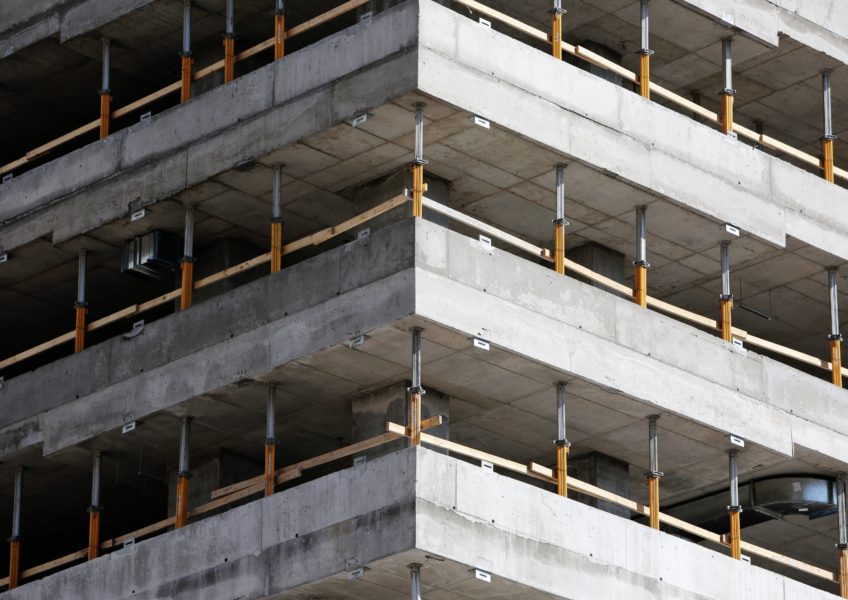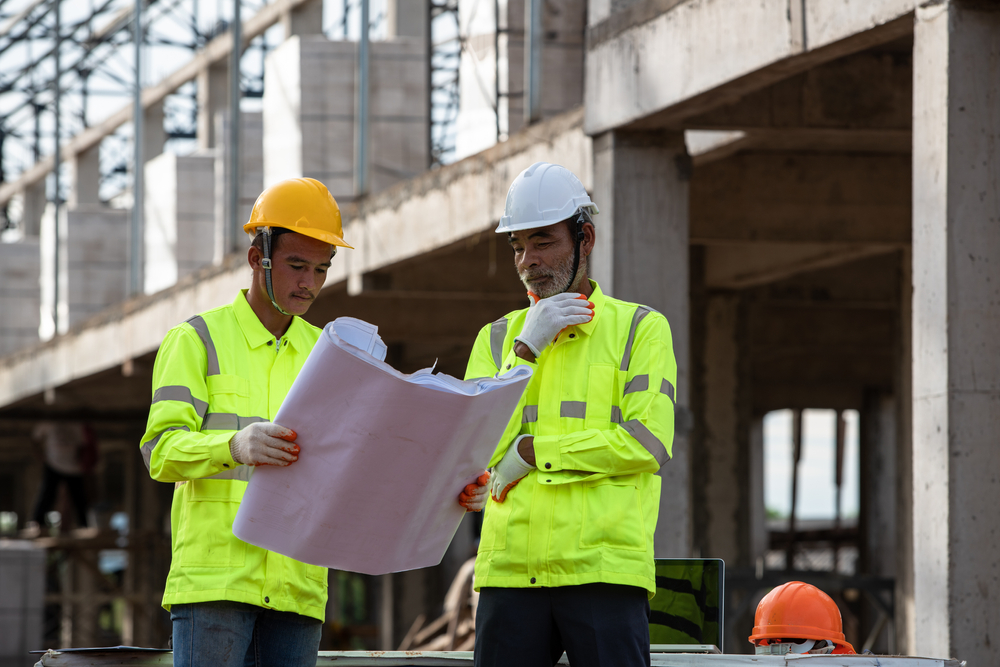Avoid These Mistakes When Hiring West Coast GE Concrete contractors for Your Next Job
Avoid These Mistakes When Hiring West Coast GE Concrete contractors for Your Next Job
Blog Article
The Necessary Function of Concrete Structure in Structural Integrity and Long Life
When it concerns building a building, the foundation is more essential than you might believe. Concrete foundations provide unrivaled stamina and resilience, ensuring your framework can hold up against numerous ecological obstacles. Without a solid base, you take the chance of prospective issues like moving or fracturing, which can endanger safety and value. Recognizing the nuances of concrete structures could be the key to protecting your investment for many years to find. So, what should you consider next?
Comprehending the Significance of Concrete Foundations
Concrete foundations are vital to the overall security of any type of structure, as they give the crucial assistance needed to stand up to different loads and environmental conditions. When you think of developing a home or an industrial area, the foundation is the first point you ought to take into consideration. It works as a barrier against moisture, protecting your property from water damage. A well-placed concrete foundation also stops settling and shifting, which can lead to cracks in wall surfaces and floorings. You'll wish to guarantee that the structure is correctly made and reinforced, as this impacts the longevity of your structure. Furthermore, a strong foundation can improve energy efficiency by reducing air leaks. Keep in mind, neglecting the relevance of a concrete structure can lead to pricey repair work down the line. Spending in a quality structure upfront is important for the integrity and resilience of your framework.
Advantages of Concrete Structures for Structural Integrity
While several elements add to a structure's architectural stability, concrete structures offer unparalleled durability and strength. You'll appreciate that concrete can stand up to extreme weather, standing up to both wetness and temperature level variations. This strength indicates your structure is less most likely to experience splitting or moving in time, which can compromise its safety.Additionally, concrete's integral weight offers a strong base, protecting against movement during natural events like earthquakes or floods. When you pick a concrete structure, you're also selecting low maintenance; unlike wood, it won't rot or attract parasites, conserving you money and time in repairs.Moreover, concrete's fire resistance uses included security, ensuring your structure can withstand heats without considerable damages. In general, buying a concrete foundation means you're focusing on the long-lasting stability and honesty of your structure, making it a sensible selection for any building and construction project.
Usual Kinds Of Concrete Foundations
When it concerns developing foundations, recognizing the usual sorts of concrete structures can help you make informed choices for your task. The most prevalent kinds consist of slab-on-grade, crawl room, and complete cellar foundations.A slab-on-grade structure is an easy, economical alternative, where a thick concrete slab is poured straight on the ground. This type functions well in cozy climates, as it minimizes warmth loss.Crawl space foundations raise the home a little above ground, enabling ventilation and access to plumbing and electrical systems. This style can help protect against wetness issues.Full basement structures provide additional living or storage space while offering exceptional structural assistance. They need more excavation and are typically made use of in chillier climates to stop frost heave.
Elements to Take Into Consideration When Creating a Concrete Foundation

Best Practices for Putting Up Concrete Foundations
When you're mounting a concrete structure, proper site preparation is necessary to assure stability (West Coast General Engineering concrete foundation). You'll also require to comprehend reinforcement techniques to enhance strength and durability. Lastly, do not neglect the treating procedure, as it plays a basic role in attaining a solid foundation
Site Preparation Value
Although it might seem straightforward, appropriate website prep work is essential for assuring a strong and durable concrete foundation. Start by clearing the area of any debris, vegetation, or natural material that might endanger the structure's honesty. Next, assess the soil kind and compaction; you may need to excavate or include products to develop a steady base. Level the ground to ensure also weight circulation and prevent clearing up problems in the future. Installing proper drainage systems is likewise vital to protect against water build-up, which can compromise the structure with time. Mark out the structure's measurements accurately to assist the pouring process. By adhering to these actions, you'll set the phase for an effective concrete structure that stands the test of time.
Reinforcement Strategies Explained
As soon as the site is correctly prepared, the next action in ensuring a strong concrete structure entails implementing efficient support techniques. You ought to start by using steel rebar, which provides tensile stamina and aids prevent splitting. Lay the rebar in a grid pattern, ensuring it's elevated using spacers to keep correct insurance coverage. Additionally, consider making use of cord mesh for added assistance, especially in areas subject to heavy loads. Don't forget to connect the rebar crossways securely with cord. For bigger structures, fiber reinforcement can enhance toughness, decreasing the threat of shrinkage cracks. Constantly adhere to neighborhood building ordinance and guidelines to make sure conformity. By applying these support strategies, you'll significantly increase your foundation's toughness and longevity, laying a strong foundation for your framework.
Curing Refine Essentials
To guarantee your concrete structure treatments effectively, it is very important to maintain adequate moisture and temperature level problems instantly after putting. Start by covering the surface area with a wet burlap or plastic sheeting to keep wetness. This keeps the concrete hydrated, protecting against fractures and ensuring stamina. You should additionally keep an eye on the temperature level; suitable treating problems are in between 50 ° F and 90 ° F. If it's as well warm, haze the surface area consistently to stop fast evaporation. For cool weather, think about making use of insulating coverings to keep warmth. Go for a treating period of a minimum of seven days, as this is essential for optimum stamina advancement. By adhering to these ideal methods, you'll boost your foundation's longevity and long life, ensuring architectural stability for several years to come.
Maintenance of Concrete Foundations for Long Life
To maintain your concrete foundation strong and long lasting, normal examinations are necessary. You should also assure helpful site efficient drainage services are in place to stop water damages. If you detect any fractures, addressing them promptly will conserve you from bigger problems down the line.

Normal Inspections and Evaluations
While regular assessments and evaluations could appear like a task, they're necessary for keeping the stability of your concrete foundation. By routinely checking for cracks, shifts, or signs of wear, you can catch prospective issues before they rise into expensive repair services. Try to find any water merging around the foundation or uncommon settling, as these can signify underlying issues. It's also a good idea to check any modifications in your house's structure, like doors that stick or home windows that don't open smoothly. Maintaining a document of your assessments aids track modifications over time, permitting positive upkeep. Eventually, these assessments assure your foundation stays secure, supporting the long life and security of your whole framework. Don't forget this vital aspect of homeownership!
Efficient Drain Solutions
Routine examinations can reveal concerns like drainage troubles that might endanger your concrete foundation's stability. To stop water accumulation, assure your rain gutters and downspouts direct water far from the foundation. Installing French drains can successfully redirect surface area and groundwater, reducing stress on your structure walls. In addition, grading the soil around your home aids ensure that water flows away, instead of pooling near your foundation.Consider using sump pumps in locations vulnerable to flooding, as they proactively remove excess water. Routinely look for obstructions in drain systems and clear them quickly. You'll protect your foundation's integrity and durability by taking these aggressive actions. Keep in mind, efficient drainage services are necessary for maintaining a strong, resilient concrete structure.
Motivate Crack Fixes
When you see splits in your concrete foundation, addressing them without delay is important for preserving its durability. Little splits can promptly advance into bigger problems, jeopardizing the structural integrity of your home. Consistently inspect your foundation for indications of damages, such as straight or vertical fractures. If you detect any kind of, don't wait-- fix them quickly. You can use epoxy shots or concrete patching compounds, which work for securing fractures. Constantly adhere to the maker's instructions and consider seeking advice from an expert for considerable damage. Keep in mind, prompt fixings not just enhance your foundation's longevity yet additionally save you cash in the future by preventing much more considerable repair work down the line. Stay positive, and your structure will stay strong and safe.
Resolving Typical Concerns With Concrete Structures
Concrete foundations can deal with different problems with time, making it critical to determine this article and resolve them promptly. Among the most typical troubles is cracking, which can occur due to temperature level fluctuations or clearing up dirt. If you see splits, it's necessary to analyze their dimension and deepness; little fractures can often be secured, while bigger ones may require specialist evaluation.Water breach is another significant worry. Excess dampness can cause mold development and architectural damage. Warranty proper water drainage around your structure to alleviate this danger. Additionally, search for indications of shifting or bowing walls, as this can show underlying concerns with your foundation's stability.Regular examinations are fundamental to capture these issues early. If you find any concerning indications, don't wait to seek advice from a foundation professional. By staying proactive, you can maintain the stability and durability of your concrete foundation, assuring your home continues to be risk-free and safe and secure.
Regularly Asked Concerns
Just How Does Soil Type Influence Concrete Structure Performance?
Dirt kind considerably influences concrete foundation efficiency. If you have actually got large clay, for instance, it can create changing and cracking. Sandy dirt might bring about working out. Recognizing your soil helps ensure a steady structure.
Can Concrete Foundations Be Repaired if Damaged?
Yes, you can fix damaged concrete structures. Depending upon the level of the damages, strategies like epoxy shot or slab jacking can recover security. It's finest to seek advice from a specialist for efficient services.
What Is the Regular Life-span of a Concrete Foundation?
A concrete foundation normally lasts 30 to 100 years, depending on elements like dirt problems, climate, and maintenance. You'll wish to watch on it to ensure it stays in excellent form throughout its Click Here lifespan.
Exist Choice Products to Concrete for Foundations?
Yes, there are choices to concrete for structures, like steel, hardwood, or also recycled materials. Each choice has special benefits and disadvantages, so you must consider your job's specific needs when selecting the appropriate material.
How Does Environment Influence Concrete Foundation Longevity?
Climate greatly influences concrete structure longevity (West Coast General Engineering industrial concrete). Severe temperature levels, wetness, and freeze-thaw cycles can compromise the material, causing fractures and architectural issues. You ought to consider local climate conditions when intending your structure to assure lasting performance
Report this page